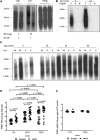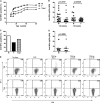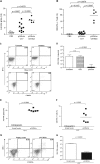Novel Woodchuck Hepatitis Virus (WHV) transgene mouse models show sex-dependent WHV replicative activity and development of spontaneous immune responses to WHV proteins
- PMID: 24257601
- PMCID: PMC3911616
- DOI: 10.1128/JVI.02086-13
Novel Woodchuck Hepatitis Virus (WHV) transgene mouse models show sex-dependent WHV replicative activity and development of spontaneous immune responses to WHV proteins
Abstract
The woodchuck model is an informative model for studies on hepadnaviral infection. In this study, woodchuck hepatitis virus (WHV) transgenic (Tg) mouse models based on C57BL/6 mice were established to study the pathogenesis associated with hepadnaviral infection. Two lineages of WHV Tg mice, harboring the WHV wild-type genome (lineage 1217) and a mutated WHV genome lacking surface antigen (lineage 1281), were generated. WHV replication intermediates were detected by Southern blotting. DNA vaccines against WHV proteins were applied by intramuscular injection. WHV-specific immune responses were analyzed by flow cytometry and enzyme-linked immunosorbent assays (ELISAs). The presence of WHV transgenes resulted in liver-specific but sex- and age-dependent WHV replication in Tg mice. Pathological changes in the liver, including hepatocellular dysplasia, were observed in aged Tg mice, suggesting that the presence of WHV transgenes may lead to liver diseases. Interestingly, Tg mice of lineage 1281 spontaneously developed T- and B-cell responses to WHV core protein (WHcAg). DNA vaccination induced specific immune responses to WHV proteins in WHV Tg mice, indicating a tolerance break. The magnitude of the induced WHcAg-specific immune responses was dependent on the effectiveness of different DNA vaccines and was associated with a decrease in WHV loads in mice. In conclusion, sex- and age-dependent viral replication, development of autoimmune responses to viral antigens, pathological changes in the liver in WHV Tg mice, and the possibility of breaking immune tolerance to WHV transgenes will allow future studies on pathogenesis related to hepadnaviral infection and therapeutic vaccines.
Figures





Similar articles
-
Persistence of the recombinant genomes of woodchuck hepatitis virus in the mouse model.PLoS One. 2015 May 5;10(5):e0125658. doi: 10.1371/journal.pone.0125658. eCollection 2015. PLoS One. 2015. PMID: 25942393 Free PMC article.
-
Replication of naturally occurring woodchuck hepatitis virus deletion mutants in primary hepatocyte cultures and after transmission to naive woodchucks.J Virol. 2001 Apr;75(8):3811-8. doi: 10.1128/JVI.75.8.3811-3818.2001. J Virol. 2001. PMID: 11264370 Free PMC article.
-
Diverse Virus and Host-Dependent Mechanisms Influence the Systemic and Intrahepatic Immune Responses in the Woodchuck Model of Hepatitis B.Front Immunol. 2020 May 27;11:853. doi: 10.3389/fimmu.2020.00853. eCollection 2020. Front Immunol. 2020. PMID: 32536912 Free PMC article. Review.
-
Coadministration of gamma interferon with DNA vaccine expressing woodchuck hepatitis virus (WHV) core antigen enhances the specific immune response and protects against WHV infection.J Virol. 2001 Jun;75(11):5036-42. doi: 10.1128/JVI.75.11.5036-5042.2001. J Virol. 2001. PMID: 11333883 Free PMC article.
-
Evaluation of new approaches to prophylactic and therapeutic vaccinations against hepatitis B viruses in the woodchuck model.Intervirology. 2001;44(2-3):124-31. doi: 10.1159/000050039. Intervirology. 2001. PMID: 11509873 Review.
Cited by
-
Persistence of the recombinant genomes of woodchuck hepatitis virus in the mouse model.PLoS One. 2015 May 5;10(5):e0125658. doi: 10.1371/journal.pone.0125658. eCollection 2015. PLoS One. 2015. PMID: 25942393 Free PMC article.
-
Virological activity in treatment-naïve HBeAg-negative HBV-infected adult patients: A community-based study in Jiangsu, China.Medicine (Baltimore). 2020 Jul 17;99(29):e21179. doi: 10.1097/MD.0000000000021179. Medicine (Baltimore). 2020. PMID: 32702877 Free PMC article.
-
Imaging, Pathology, and Immune Correlates in the Woodchuck Hepatic Tumor Model.J Hepatocell Carcinoma. 2021 Mar 9;8:71-83. doi: 10.2147/JHC.S287800. eCollection 2021. J Hepatocell Carcinoma. 2021. PMID: 33728278 Free PMC article.
-
Activity of nucleic acid polymers in rodent models of HBV infection.Antiviral Res. 2018 Jan;149:26-33. doi: 10.1016/j.antiviral.2017.10.022. Epub 2017 Nov 8. Antiviral Res. 2018. PMID: 29126900 Free PMC article.
References
Publication types
MeSH terms
Substances
LinkOut - more resources
Full Text Sources
Other Literature Sources
Medical
Molecular Biology Databases
Miscellaneous

